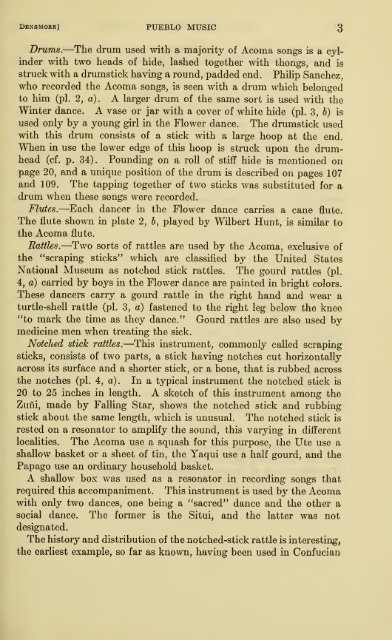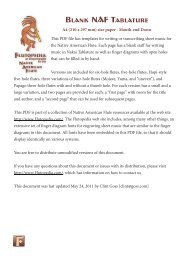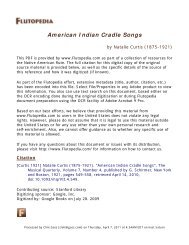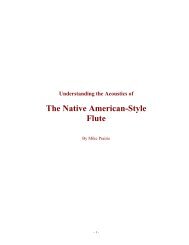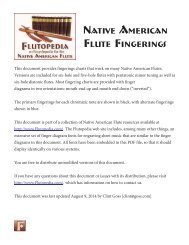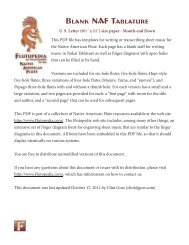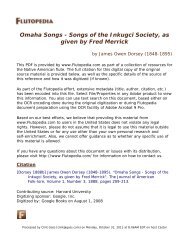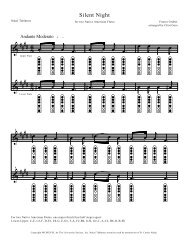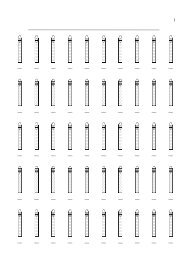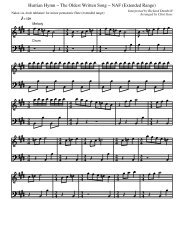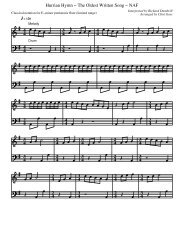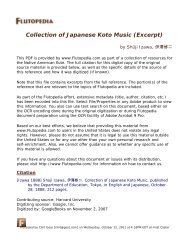Music of Acoma, Isleta, Cochiti, and Zuñi Pueblos - Flutopedia.com
Music of Acoma, Isleta, Cochiti, and Zuñi Pueblos - Flutopedia.com
Music of Acoma, Isleta, Cochiti, and Zuñi Pueblos - Flutopedia.com
You also want an ePaper? Increase the reach of your titles
YUMPU automatically turns print PDFs into web optimized ePapers that Google loves.
Dhnsmobb] pueblo music '3<br />
Drums.—The drum used with a majority <strong>of</strong> <strong>A<strong>com</strong>a</strong> songs is a cylinder<br />
with two heads <strong>of</strong> hide, lashed together with thongs, <strong>and</strong> is<br />
struck with a drumstick having a round, padded end. Philip Sanchez,<br />
who recorded the <strong>A<strong>com</strong>a</strong> songs, is seen with a drum which belonged<br />
to him (pi. 2, a). A larger drum <strong>of</strong> the same sort is used with the<br />
Winter dance. A vase or jar with a cover <strong>of</strong> white hide (pi. 3, 6) is<br />
used only by a young girl in the Flower dance. The drumstick used<br />
with this drum consists <strong>of</strong> a stick with a large hoop at the end.<br />
When in use the lower edge <strong>of</strong> this hoop is struck upon the drumhead<br />
(cf. p. 34). Pounding on a roll <strong>of</strong> stiff hide is mentioned on<br />
page 20, <strong>and</strong> a unique position <strong>of</strong> the drum is described on pages 107<br />
<strong>and</strong> 109. The tapping together <strong>of</strong> two sticks was substituted for a<br />
drum when these songs were recorded.<br />
Flutes.—Each dancer in the Flower dance carries a cane flute.<br />
The flute shown in plate 2, h, played by Wilbert Hunt, is similar to<br />
the <strong>A<strong>com</strong>a</strong> flute.<br />
Rattles.—Two sorts <strong>of</strong> rattles are used by the <strong>A<strong>com</strong>a</strong>, exclusive <strong>of</strong><br />
the "scraping sticks" which are classified by the United States<br />
National Museum as notched stick rattles. The gourd rattles (pi.<br />
4, a) carried by boys in the Flower dance are painted in bright colors.<br />
These dancers carry a gourd rattle in the right h<strong>and</strong> <strong>and</strong> wear a<br />
turtle-shell rattle (pi. 3, a) fastened to the right leg below the knee<br />
"to mark the time as they dance." Gourd rattles are also used by<br />
medicine men when treating the sick.<br />
Notched stick rattles.—This instrument, <strong>com</strong>monly called scraping<br />
sticks,<br />
consists <strong>of</strong> two parts, a stick having notches cut horizontally<br />
across its surface <strong>and</strong> a shorter stick, or a bone, that is rubbed across<br />
the notches (pi. 4, a). In a typical instrument the notched stick is<br />
20 to 25 inches in length. A sketch <strong>of</strong> this instrument among the<br />
Zuni, made by Falling Star, shows the notched stick <strong>and</strong> rubbing<br />
stick about the same length, which is unusual. The notched stick is<br />
rested on a resonator to amplify the sound, this varying in different<br />
localities. The <strong>A<strong>com</strong>a</strong> use a squash for this purpose, the Ute use a<br />
shallow basket or a sheet <strong>of</strong> tin,<br />
the Yaqui use a half gourd, <strong>and</strong> the<br />
Papago use an ordinary household basket.<br />
A shallow box was used as a resonator in recording songs that<br />
required this ac<strong>com</strong>paniment. This instrument is used by the <strong>A<strong>com</strong>a</strong><br />
with only two dances, one being a "sacred" dance <strong>and</strong> the other a<br />
social dance. The former is the Situi, <strong>and</strong> the latter was not<br />
designated.<br />
The history <strong>and</strong> distribution <strong>of</strong> the notched-stick rattle is interesting,<br />
the earliest example, so far as known, having been used in Confucian


